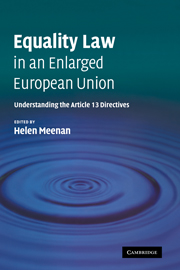2 - Article 13 EC, evolution and current contexts
Published online by Cambridge University Press: 22 August 2009
Summary
Introduction
Amongst the most exciting of the new possibilities in the Amsterdam Treaty is the provision enabling European legislation to be made in relation to equality and non-discrimination. This provision is contained in Article 13 EC, which as then agreed, stated:
Without prejudice to the other provisions of this Treaty and within the limits of the powers conferred by it upon the Community, the Council, acting unanimously on a proposal from the Commission and after consulting the European Parliament, may take appropriate action to combat discrimination based on sex, racial or ethnic origin, religion or belief, disability, age or sexual orientation.
It was clear from the outset that action under Article 13 depended for its content on proposals from the European Commission. As soon as the Amsterdam Treaty was agreed the Commission began to mull this over. There was time to do this. Although the Amsterdam Treaty was signed by the high representatives on 2 October 1997 it required ratification by each Member State to come into effect. This was not concluded until 1 May 1999, and the hiatus provided a useful opportunity for some preliminary consideration as to the effect that would be given to it. For this purpose the Commission held a major conference over 3 and 4 December 1998 to discuss what could and should be done with Article 13.
Information
- Type
- Chapter
- Information
- Equality Law in an Enlarged European UnionUnderstanding the Article 13 Directives, pp. 38 - 72Publisher: Cambridge University PressPrint publication year: 2007
Accessibility standard: Unknown
Why this information is here
This section outlines the accessibility features of this content - including support for screen readers, full keyboard navigation and high-contrast display options. This may not be relevant for you.Accessibility Information
- 2
- Cited by
